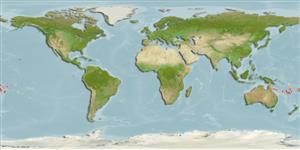>
Ovalentaria/misc (Various families in series Ovalentaria) >
Pomacentridae (Damselfishes) > Pomacentrinae
Etymology: Pomacentrus: Greek, poma, -atos = cover, operculum + Greek, kentron = sting (Ref. 45335); nigriradiatus: Named for the dark rays on the posterior sections of the median fins; a compound adjective..
Environment: milieu / climate zone / depth range / distribution range
Ecologie
marien rifbewoner; diepte 8 - 20 m (Ref. 114927). Tropical
Verspreiding
Landen | FAO regio's | Ecosystemen | Voorkomen | Point map | Introducties | Faunafri
South Pacific: New Caledonia to American Samoa, including Loyalty Islands, Vanuatu, Rotuma, Wallis, and Samoa (formerly Western Samoa).
Grootte / Gewicht / Leeftijd
Maturity: Lm ? range ? - ? cm
Max length : 7.4 cm SL mannelijk / geslacht onbekend; (Ref. 114927)
Korte beschrijving
Morfologie | Morfometrie
Dorsale stekels (totaal): 13; Dorsale zachte stralen (totaal): 14-15; Anale stekels 2; Anale zachte stralen: 14 - 15; Wervels: 26. This species is distinguished by the following characters: D XIII,14-15; A II,14-15; pectoral-fin rays usually 17-18 (rarely 17); tubed lateral-line scales 17-19 (rarely 19); total gill rakers on first arch 22-24 (rarely 22); body depth 2.0-2.2 in SL; a patch of scales usually present on preorbital and a single row of scales on suborbital, continuing around posterior margin of eye; color in life generally gray to gray brown with thick black or dark-brown scale margins producing a network pattern; a black spot covers entire pectoral-fin base; inner side of pectoral-fin axil tannish to pale gray; median fins dark gray with translucent portion posteriorly showing conspicuous contrasting blackish rays; dorsal scleral surface of eye either uniform grayish or with a few blue markings. This species differs from other members of the philippinus species complex by the distinct color pattern features, particularly the obvious contrasting dark fin rays on the posterior sections of the dorsal, anal, and caudal fins; also differs from P. albiaxillaris, P. flavoaxillaris, and P. magniseptus in usually having at least a few scales on the preorbital (lacking in three of the many type specimens) (Ref, 114927).
Levenscyclus en paargedrag
Maturiteit | Voortplanting | Paaien | Eieren | Fecunditeit | Larven
Allen, G.R., M.V. Erdmann and P.D. Pertiwi, 2017. Descriptions of four new species of damselfishes (Pomacentridae) in the Pomacentrus philippinus complex from the tropical western Pacific Ocean. J. Ocean Sci. Found. 25:47-76. (Ref. 114927)
Status op de Rode Lijst van het IUCN (Ref. 130435)
Gevaar voor de mens
Harmless
Gebruik door de mens
Meer informatie
LandenFAO regio'sEcosystemenVoorkomenIntroductiesStocksEcologieDieetVoedselitemsVoedselconsumptieRantsoen
Lokale namenSynoniemenMetabolismePredatorenEcotoxicologieVoortplantingMaturiteitPaaienPaaiaggregatiesFecunditeitEierenOntwikkeling van de eieren
Leeftijd/GrootteGroeiLengte-gewichtLengte-lengteLengtefrequentiesMorfometrieMorfologieLarvenLarvale populatiedynamiekRekruteringAbundantieBRUVS
ReferentiesAquacultuurAquacultuurprofielKweeklijnenGeneticaElectrophoresesErfelijkheidZiektesVerwerkingNutrientsMassaconversie
Tools
Speciale rapporten
Download XML
Internetbronnen
Estimates based on models
Fylogenetische diversiteitsindex (Ref.
82804): PD
50 = 0.5000 [Uniqueness, from 0.5 = low to 2.0 = high].
Bayesian length-weight: a=0.02399 (0.01139 - 0.05051), b=2.98 (2.81 - 3.15), in cm total length, based on LWR estimates for this Genus-body shape (Ref.
93245).
Trofisch niveau (Ref.
69278): 2.7 ±0.3 se; based on size and trophs of closest relatives
Weerstandsvermogen (Ref.
120179): Hoog, minimale populatieverdubbelingstijd minder dan 15 maanden (Preliminary K or Fecundity.).
Fishing Vulnerability (Ref.
59153): Low vulnerability (10 of 100).
